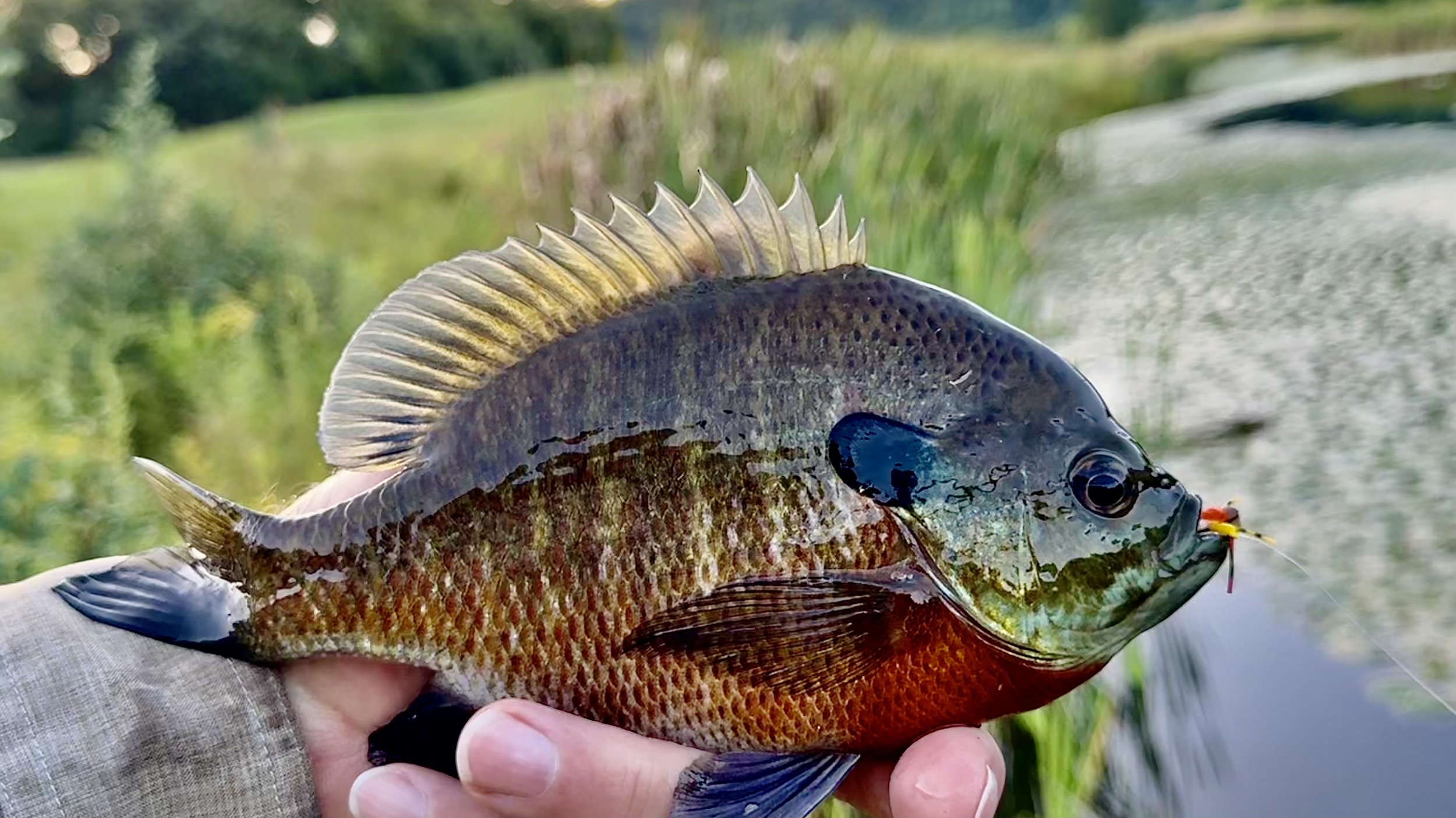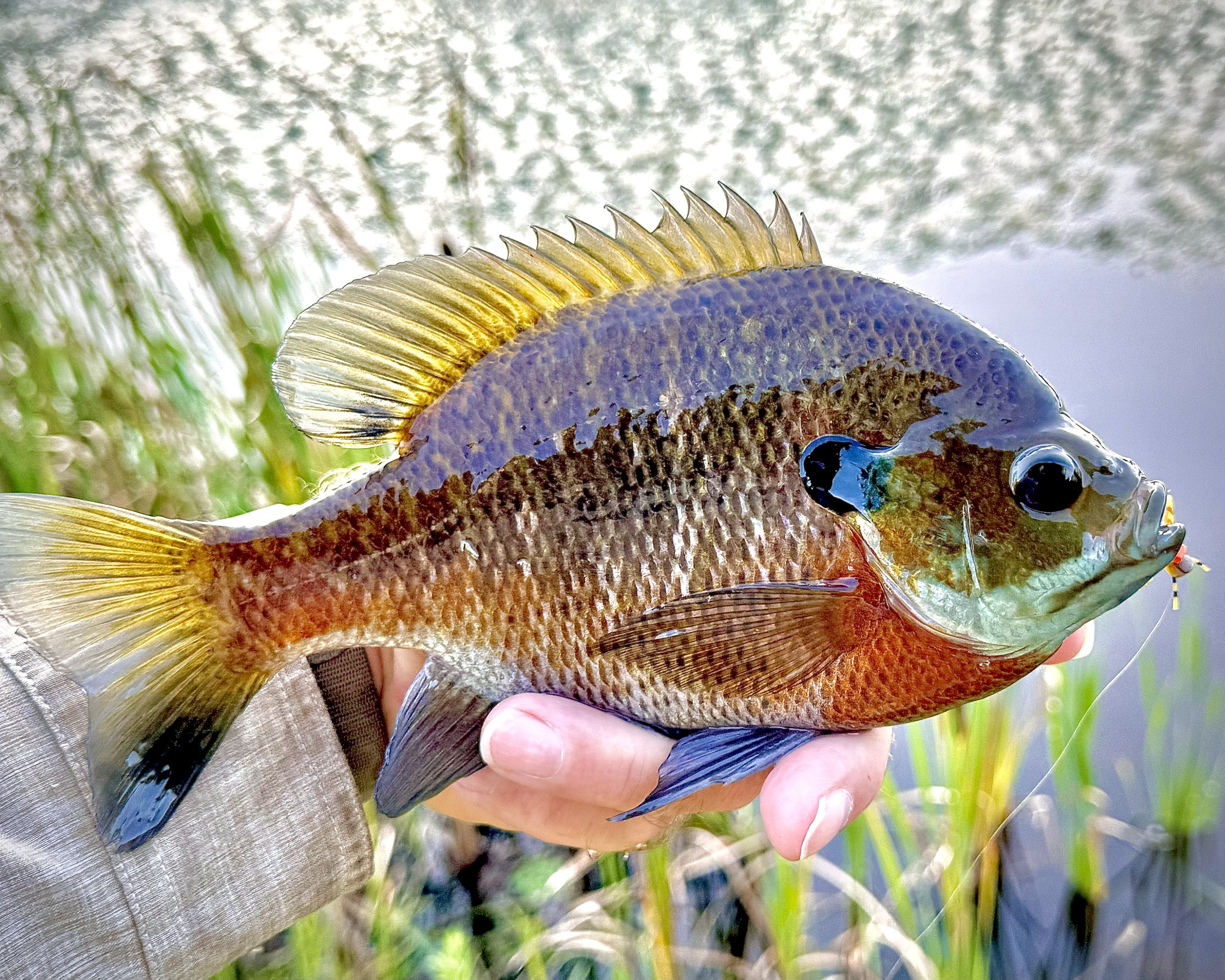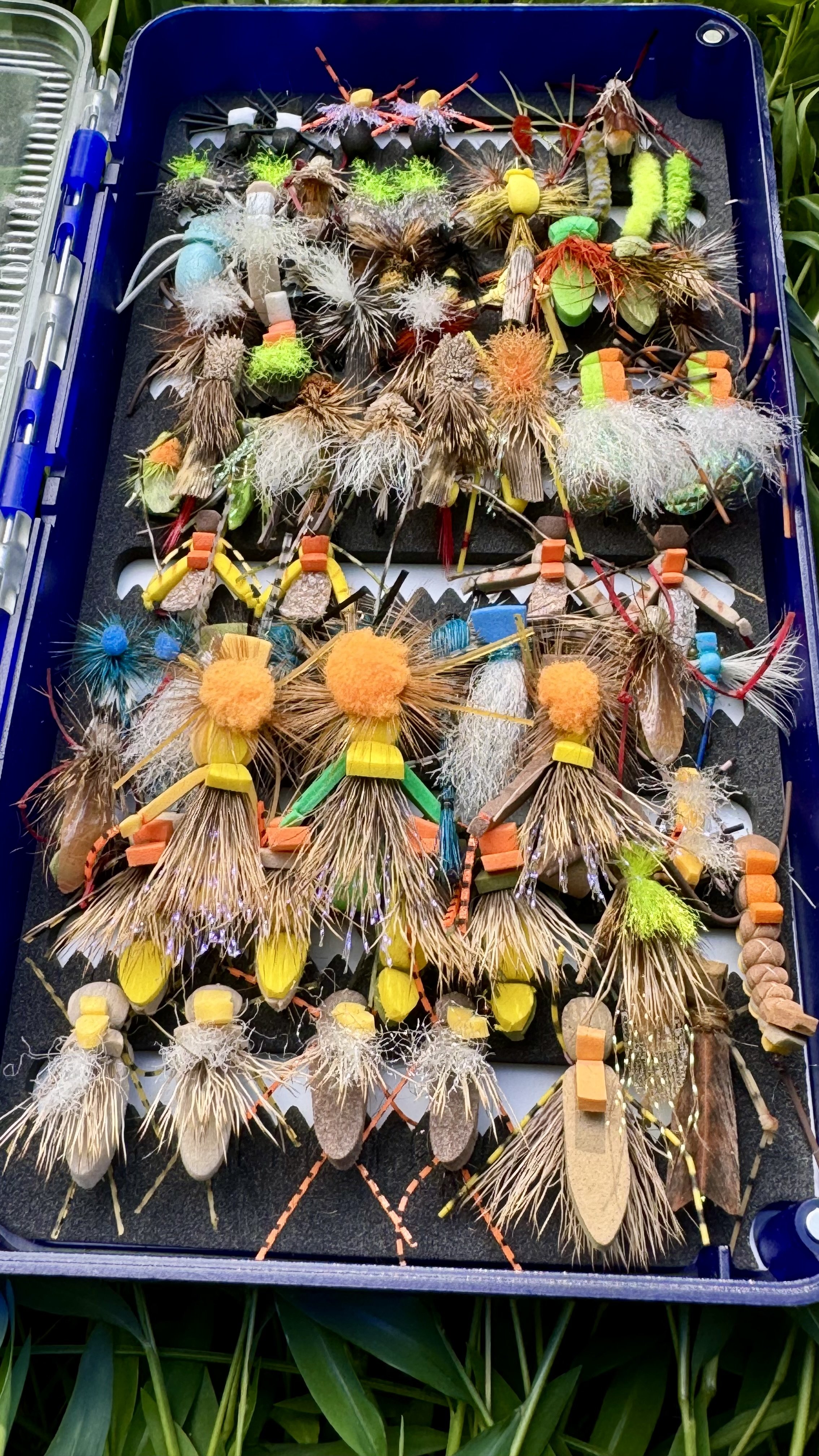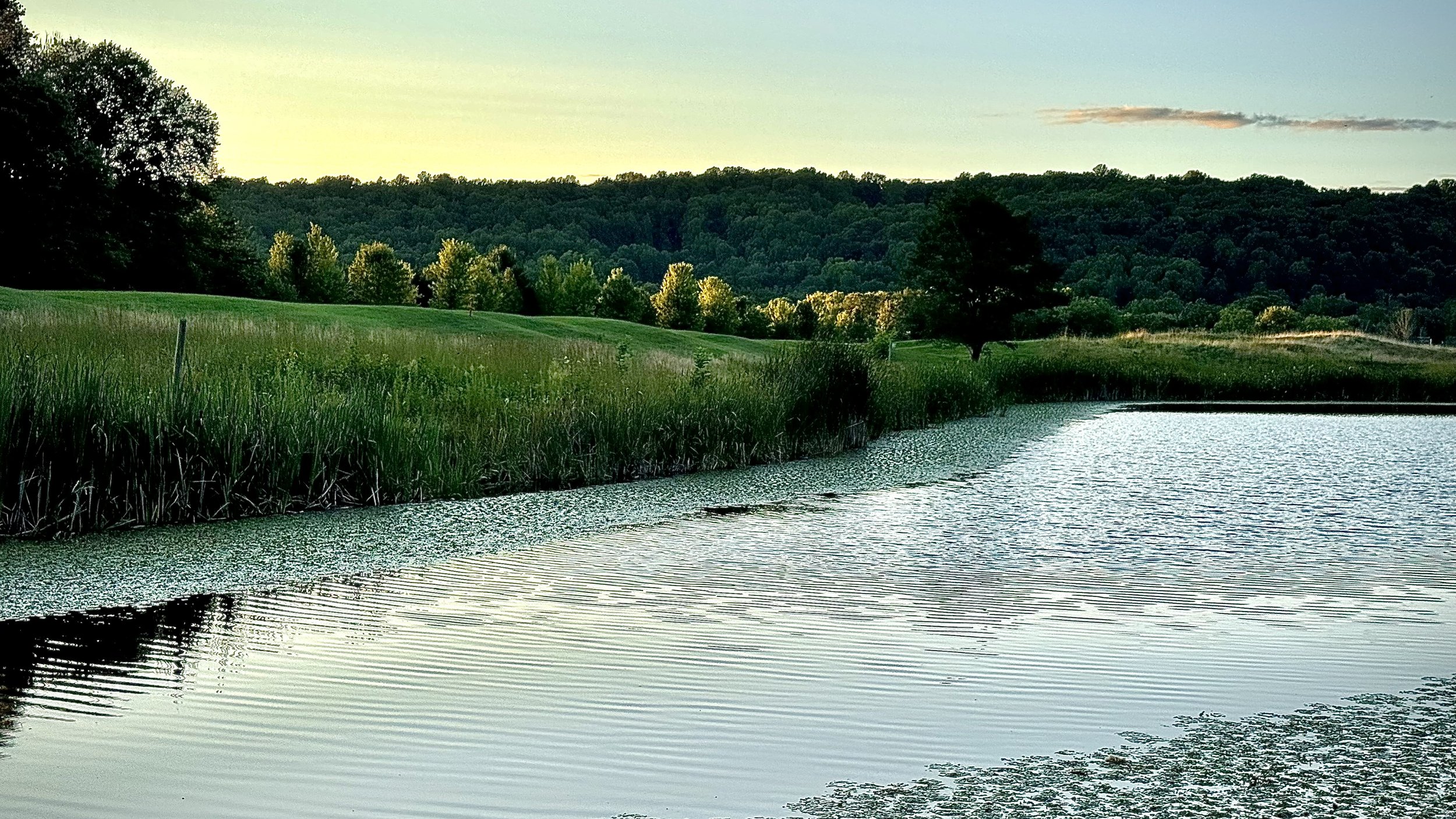When folks discuss hoppers and fly fishing, the conversation almost always concerns trout. But what about panfish? Are they just as crazy over these giant bugs as their sexy cold-water cousins? The answer is yes! Grasshoppers turn fish on, whether it's a monster brown trout or a big fat bluegill.
When To Fish Hoppers
The best time to fish hoppers is when these big bugs are active, generally during the warmest part of the year, which is now! While any fish is likely to see a grasshopper floating on the surface as a potential meal, they are more apt to grab them when they see them regularly. That means fishing grasshopper imitations along grassy banks where grasshoppers will likely find their way into the water. While grasshoppers may find themselves in the drink at any time, they are more likely to get wet on windy days when a stiff breeze blows them off their perch or interferes with their flight plan.
Grassy shorelines, except on golf courses, are rare on most ponds and lakes I fish. I have access to several golf course ponds where I can fish when golfers are not present. These ponds are surrounded by vegetation that is a prime habitat for hoppers of all shapes and sizes, as well as a plethora of other types of terrestrial insects. If you don't have access to a golf course pond, look for bodies of water with a stretch of grassy bank. Find grass, and you will find hoppers.
Each year, I look forward to the dog days of summer, when the walk from the truck to the ponds will drench you in so much sweat that you feel like you just took a dip in a swimming pool, fully clothed. It is during these hot spells that grasshoppers are the most active. The middle of the day is too hot for me and likely too hot for the fish, so I limit my fishing to the last few hours of the day. I prefer to fish early in the morning when the air and the water are at their lowest temperatures, but early mornings are also popular with golfers for the same reason.
A panfish sized grasshopper imitation.
The Bugs
Real grasshoppers come in all shapes, sizes, and colors, as do the flies that imitate them. For panfish, I prefer fishing smaller versions of this popular fly. While large bluegill can take down any size hopper, I often observe them taking down the largest insects in stages. I have watched them drag the helpless insect down repeatedly. Each time the hopper resurfaces, it is missing another part of its anatomy until it disappears in a swirl for good. They will do the same to your flies, grabbing them by a leg and pulling them under. This behavior can result in a lot of missed hits. When fishing a smaller hopper pattern, the fish are more likely to grab the whole fly, resulting in more hookups. When targeting panfish, I prefer hopper imitations in sizes 12 and 14, but there are always a few big bugs in the box to throw at a cruising bass or to bring jumbo bluegill up from the depths.
Grasshopper imitations can bring big bluegills to the surface.
Fishing Hopper Imitations
Grasshoppers don't enter the water gently; they do it with a good SPLAT! Your flies should do the same. The sound of a hopper hitting the water is like ringing a dinner bell, whether you're on a blue-ribbon trout stream or a local park pond. When fishing hoppers, I try to drive the fly into the water so it hits hard, creating a disturbance.
The next part is the hardest. Do nothing for as long as you can stand it, and when you can't stand it any longer, wait a few seconds longer before moving the fly. Bluegills and other sunfish (even bass) will often slide up underneath the floating bug (regardless of whether it is the real deal or a fly tied to the end of your leader) and study it, waiting for a sign known only to them that it's time to eat. A slight twitch is usually all it takes to get them to commit. The key is to animate the fly in place without moving it across the water's surface. You accomplish this by removing as much slack as possible from the fly line. Then, when you have the line as tight as possible (without moving the fly), give the rod grip a good rap with your thumb or tap it with your non-rod hand. This action will send vibrations down the line and cause the fly to wiggle without changing its position on the water. Do this two or three times before attempting to retrieve it.
A grasshopper will usually attempt to "swim" back to shore if it survives the landing without getting eaten. They have an uncanny ability to orient themselves, so their movements bring them closer to shore. They will propel themselves in short spurts, an action easily replicated with a fly rod, especially a shore-based one. If fishing from a boat or tube, try casting parallel to the bank and retrieving the fly along the bank instead of away from it. Panfish often grab the insect when it pauses, and bass seem fond of taking them on the move.
The hopper box. containing an assortment of hopper patterns with a few other terrestrial insects thrown in for good measure.
My Favorite Hopper Patterns
My hopper box is loaded with various hopper patterns in different sizes and colors, and a few terrestrial patterns are thrown in for good measure. Some are built entirely of foam and rubber, others from buoyant natural materials like deer hair, and a few combine foam and natural materials for the best of both worlds. Foam flies float all day long with no need for drying out or treating with floatant, and they are very durable. Hopper imitations like Dave's (Dave Whitlock) Hopper are made from natural materials like deer hair, turkey fibers, and yarn, which will absorb water over time and require drying out and/or treating with floating. Dave's Hopper is not as durable as all foam patterns, but something magical happens when they get all chewed up. The worse they look, the better they fish. I have had success fishing sunken hopper imitations in moving water, but the fish prefer them on top in still water. So keep your bugs dry and floating high!
Perfect conditions for fishing hoppers. A grass lined bank on a breezy, late summer evening.
Overcast evenings tend to be more productive than clear ones, especially when the dark clouds of a thunderstorm are on the horizon. Something about an approaching storm makes fish feed more urgently. However, play it safe and be off the water well before lightning shows up. Even on a day with bluebird skies, the fish will start looking up once the sun gets low on the horizon. Don't let this summer pass without spending a sultry evening on the water, throwing hoppers along a grassy shoreline. You will not be disappointed.




